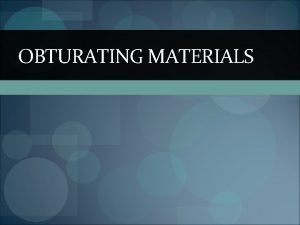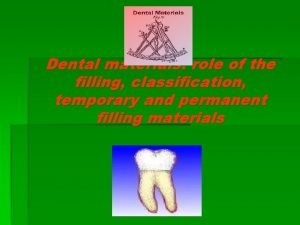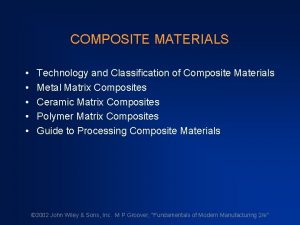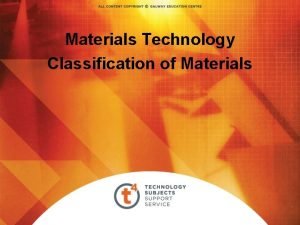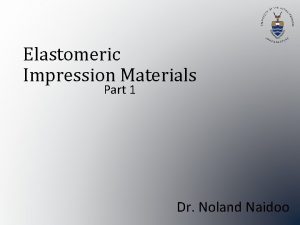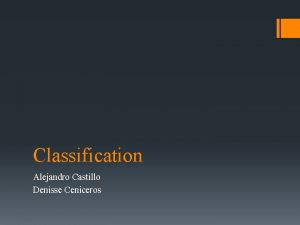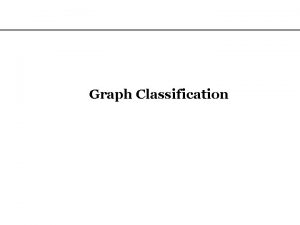Chapter 02 Classification of materials Classification of materials











- Slides: 11

Chapter #02 Classification of materials.

Classification of materials. • • Basically engineering materials are mainly classified as metals and non metals. (Metals. Those materials which possess luster on polishing and conductivity are generally known as metals or metallic materials e. g iron Cu, Al etc. Further metals are divided in to two classes as ferrous metals and non ferrous. Ferrous metals. All metallic materials which possess iron as a main constituent are popularly known as ferrous metals or ferrous materials e. g; wrought iron and steel etc. Non ferrous metals. Those metallic materials which do not possess iron as their main constituent are popularly known as non ferrous metal or materials e. g; zinc, tin and lead etc. Non metals. Those materials which mostly have low value of luster, strength and conductivity are known as non metallic material or metals e. g; ceramics, polymers and composite etc. Note. Those elements which possess properties of both metals and non metals are called metalliods.

Occurrence of engineering materials/metals. • • • Materials and metals occur in two form depending upon their electro positive characteristics. Free or native state. A few metals particularly noble metals having least electro positive characteristics occur in free or in native state are called free/native metals, for example gold, silver and platinum etc. On the other hand the metals fond in combine form which have high electro positive characteristics are called combined metals most of these types of metals occur in nature in compound state for example iron, copper and aluminum (as a mineral). Mineral is defined as it is a compound of ore and gaunge material is called mineral. Ore. It is defined as it is a compound/ mixture of metallic and nonmetallic elements is called ore, for example ferric oxide(Fe 2 o 3), it posses ferrous as a metallic element and oxygen as a non metallic element. Gange. It posses un wanted elements like rocky, dusty and sandy particles.

• • Classification of ores. There are two classes of ores native and combine state. Types of ores. Basically there are so many types of ores but in practical some most important types of ores are used for engineering purposes in the different industries which are given below. Oxide ores. Those ores which contain some %age of oxygen is called oxide ores. Carbonate ores. Those ores which contain carbon in combine is called carbonate ores. Sulphide ores. Those which contain sulphur are called sulphide ores. Silicous ores. Those which posses silicon are called silicous ores. Phosphoric ores. Those which posses phosphorous in combine form are called phosphoric ores. Note. Actually these all oxygen, carbon, silicon etc are very harm full elements for materials/ metals that is why these impurities should be removed of and purify the engineering materials/ metals for engineering use.

PROPERTIES OF MATERIALS • • • MECHANICAL PROPERTIES: Mechanical properties are the most important requirements of materials from the engineering part of view in selecting them for design purpose. Mechanical properties include the action of external forces. A designer (Engineer) must have a considerable knowledge of materials and their properties. Elasticity: It is the property of the material, which enables to regain its original shape, and size after removal of load is known as elasticity. For each elastic body a certain limit exists beyond which the material will hold a remaining deformation. This limit is called elastic limit. Plasticity: It is the property of the material, which enables the deformation or permanent deformation, under the load. Or in other words that a material can not regain its original position after removal of a load is called plasticity.

• • • Ductility: It is the property of the material which enables it to be drawn out or elongated to an appreciable extent before repute under the load is called ductility. This property is most important of the materials under rolling, forging and extrusion processes. Hardness: It is property of the material, which enables to resist easy abrasion indentation, machining and scratching by harder body is called hardness. Brittleness. It is the property of material which break without any deformation under the load is called brittleness. Malleability. It is the property of material of getting the desire shape under the compressive load without any breaking or cracking is called malleability.

• Strength. It is the capacity or property of material to with stand or sustained the high load under tension is called strength. • Toughness. It is the ability of a material which absorb the energy/ impact load without any fracture is called toughness. • Creep. It is the ability of a material which resist the slow and continuous deformation under steady load and some temperature is called creep. • Fatigue. It is the ability of a material which resist the deformation under repeated load for large number of cycles is called fatigue. • Wear Resistance: It is the property of material which resist to easy removal of a solid material by rubbing off the surface is called Wear Resistance.

• • • PHYSICAL PROPERTIES: Physical properties are employed to describe a material under conditions in which external forces are not concerned. In case of metals some important physical properties are given below. (i) Luster: the ability of the surface of the material to reflect the light is known as luster. All metals when polished have luster (accept lead). This property is greatly classifying a material is metallic or Non metallic. For Example: Mild, Steel has some smooth finish with bluish black shine, and cast iron shows sandy fracture. (ii) Color: This is the property of a material displaying a particular appearance in a normal daylight is called color. For Example: Aluminum has white, when the Cu has yellowish, red and iron has grayish in color and soon. (iii) Density: The density is defined as the wt: per unit volume of mat: is known as its density. Different materials posse’s different density it is the very help full property of material that we can justify either the metal is light or heavy. According to periodic table the density of the elopement shows that density increase regularly with increasing the automatic number. For Example: Al has 2. 7, Cu has 8. 7 etc.

• (iv). Melting Point: the temperature at which the solid substances (Metals) changes into the liquid or molten state is called the melting point. • For Example: Al has 660 0 C, Cu has 1083 0 C and iron has 1535 0 C. • (v). Porosity: A material is said to be porous if it absorb lubricants/liquid easily is called porosity. • (vi). Thermal expansion: It is the property of material when the material increases in dimensions on application of heat is called thermal expansion.

• Chemical properties. • Corrosion: It is the property of a material by which it deteriorate by chemical reaction with its environment is known as corrosion, it degrades material properties and reduces economic value of the material.

• Technical properties of materials: • (i). Machine ability: It is the property of the material, which enables it to be machined easily in the desire shape by cutting tools is called machine ability. It signifies how much force and power are required to removes stock from the material. In another sense machine ability has been used to signify how well a material takes place a good finish. • Simply it is to say that machine ability is the ease by which metal can be removed in various machining operations. • (ii) Cast ability: it is the ability of a material which can be cast into to the desire form/component is known as cast ability. • The metals which can not be easily machined they can cast easily. • For example cast iron can not easily machined. • (iii) Weld ability: it is the property of a material which can be easily welded is called weld ability.
 Go noodle cant stop the feeling
Go noodle cant stop the feeling About useful and harmful materials
About useful and harmful materials Man made map
Man made map Adopting and adapting teaching materials
Adopting and adapting teaching materials Direct materials budget with multiple materials
Direct materials budget with multiple materials Biocalex
Biocalex Negative impression dental
Negative impression dental Dental filling classification
Dental filling classification Composite materials classification
Composite materials classification Dovetail saw classification
Dovetail saw classification Examples of materials technology
Examples of materials technology Disadvantages of addition silicone
Disadvantages of addition silicone





